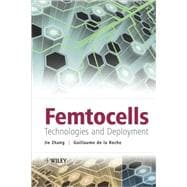
Note: Supplemental materials are not guaranteed with Rental or Used book purchases.
Purchase Benefits
What is included with this book?
He received his PhD in industrial automation from East China University of Science and Technology (www.ecust.edu.cn), Shanghai, China, in 1995. From 1997 to 2001, he was a postdoctoral research fellow with University college London, Imperial College London, and Oxford University.
Guillaume de la Roche has been working as a research fellow at the Centre for Wireless Network Design (UK) since 2007. He received the Dipl-Ing in Telecommunication from the School of Chemistry Physics and Electronics (CPE Lyon), France, an MSc degree in Signal Processing (2003) and PhD in Wireless Communication (2007) from the National Institute of Applied Science (INSA Lyon), France.
Alvaro Valcarce obtained is MEng in telecommunications engineering from the University of Vigo (Spain) in 2006. During 2005 he worked at 'Telefonica I+D' in Madrid (Spain), integrating an applications-streaming platform into an 'ATG Dynamo Server', as well as developing a system for applications-on-demand'.
David Lopez-Perez received his bachelor and master degrees in telecommunication from Miguel Hernandez University, Elche, Alicante (Spain) in 2003 and 2006, respectively. He joined Vodafone Spain in 2005, working at the Radio Frequency department in the area of network planning and optimization. he participated in the development of the Vodafone Automatic Frequency Planning tool for GSM and DCS networks.
Enjie Liu is a Senior Lecturer at the Department of Computer Science and Technology of the University of Bedfordshire. She joined UoB in 2003. She is a member of the Networking teaching group in the department and responsible for delivering both wired and wireless modules to undergraduates as well as post graduates. She received her PhD from Queen Mary College, University of London in 2002. Then she worked as research fellow with the Centre for Communication Systems Research (CCSR), the University of Surrey. She was grated a Newly Appointed Lecturers Award by The Nuffield Foundation.
Hui Song is a PhD student and research associate at the Center for Wireless Network Design (CWiND), University of Bedfordshire. His interests is network planning and optimization technologies. His current focus is on modeling OFDM fading channels. before joining CWiND, he was the manager of eh technology department at Bynear Telecom Software Ltd, Shanghai, China. There he was responsible for developing and maintaining the nation-first network planning and optimization suite (including GSM, WCDMA and TD-SCDMA). Song holds a mathematics degree from Fudan University, Shanghai, China. He currently resides in the United Kingdom.
| About the authors | |
| Preface | |
| Acknowledgements | |
| Acronyms | |
| Introduction | |
| The indoor coverage challenge | |
| Concepts of femtocells | |
| Why is femtocell important? | |
| Deployment of femtocells | |
| Important facts to attract more customers | |
| The structure of the book | |
| References | |
| Indoor Coverage Techniques | |
| Improvement of the Indoor coverage | |
| Outdoor cells | |
| Repeaters | |
| Distributed Antenna Systems (DAS) | |
| Radiating or Leaky Cable | |
| Indoor Base stations | |
| Comparison of the Indoor coverage techniques | |
| References | |
| Access Network Architecture | |
| Overview | |
| GAN based Femtocell-to-Core Network Connectivity | |
| 3GPP Iuh (Iu-home) for Home NodeB | |
| Evolution to IMS/HSPA+/LTE | |
| Architecture with IMS Support | |
| References | |
| Air-interface technologies | |
| Introduction | |
| 2G femtocells: GSM | |
| 3G femtocells: UMTS & HSPA | |
| OFDM-based femtocells | |
| References | |
| System-Level Simulation for Femtocell Scenarios | |
| Network Simulation | |
| Link and System Level Simulations | |
| Wireless Radio Channel Modeling | |
| Static and Dynamic System-Level Simulations | |
| Static System Level Methodology for WiMAX Femtocells | |
| Coverage and Capacity Analysis for WiMAX Femtocells | |
| Overview on Dynamic System-Level Simulation | |
| References | |
| Interference in the presence of femtocells | |
| Introduction | |
| Key Concepts | |
| Interference Cancellation | |
| Interference Avoidance | |
| Interference management with UMTS | |
| Conclusion | |
| References | |
| Mobility Management | |
| Introduction | |
| Mobility Management for Femtocells in 3GPP | |
| Femtocell Characterization | |
| Access Control | |
| Paging Procedure | |
| Cell Selection and Reselection | |
| Cell Handover | |
| References | |
| Self-organization | |
| Self-organization | |
| Self-configuration, Self-optimization and Self-healing | |
| Self-Organization in Femtocell Scenarios | |
| Start-up procedure in Femtocells | |
| Sensing the Radio Channel | |
| Self-configuration and self-optimization of femtocell parameters | |
| References | |
| Further femtocell issues | |
| Timing | |
| Femtocell security | |
| Femtocell location | |
| Access methods | |
| Need for new applications | |
| Health issues | |
| References | |
| Index | |
| Table of Contents provided by Publisher. All Rights Reserved. |
The New copy of this book will include any supplemental materials advertised. Please check the title of the book to determine if it should include any access cards, study guides, lab manuals, CDs, etc.
The Used, Rental and eBook copies of this book are not guaranteed to include any supplemental materials. Typically, only the book itself is included. This is true even if the title states it includes any access cards, study guides, lab manuals, CDs, etc.